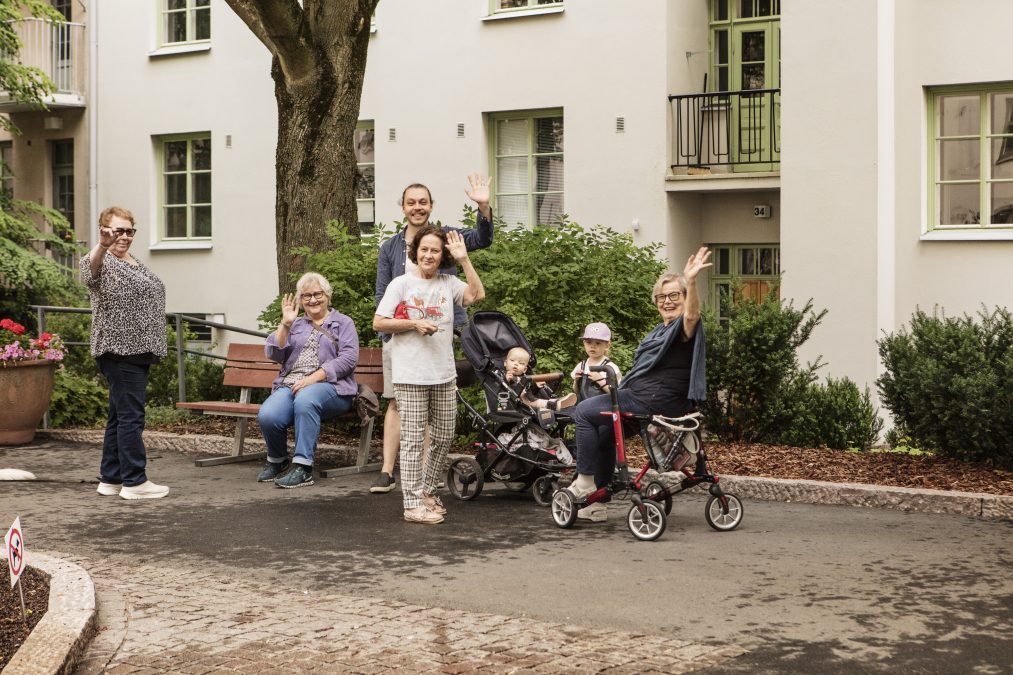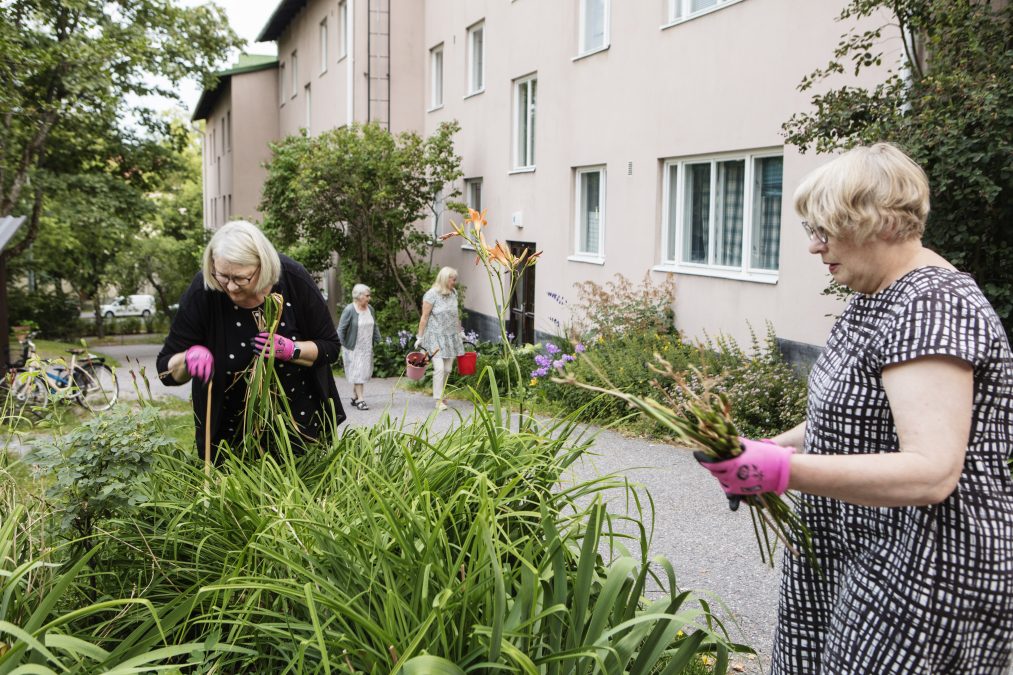When the neighbour does not want a shared yard – Conflict resolution ideas
The development of a common courtyard often involves a wide range of perspectives and feelings. We compiled the most common concerns and some tips to overcome them.

At best, the renovated block courtyard will be pleasant and important for all residents.
It is therefore desirable that as many residents as possible participate in the development. The development of the block courtyard will probably raise concerns and bring about different emotions. Dealing with them is an important stage in courtyard renovation, and it should not be avoided or ignored.
It’s common for people to become interested in things at their own pace. New ideas may also raise doubts, even resistance, among residents, shareholders and decision-makers of the housing company. It is only natural. Critical questions and opinions should be welcomed with gratitude, as they indicate that the courtyard is important to people. Listening to the speaker’s arguments makes it possible to obtain important information and new perspectives. An opponent may become a courtyard promoter once they get to voice their issue.
We compiled concerns related to establishing block courtyards and answers that can be used as support for the debate and your own arguments. Shared courtyards are created by working together.
Frequently raised concerns
”Parking spaces are important. We have to keep them.”
Parking spaces in the courtyard will certainly make life easier for car owners, but if there are only parking spaces in the courtyard, the cars will deprive other residents of the opportunity to enjoy the courtyard. Small children cannot be allowed to play safely and freely in the parking lot and an asphalt courtyard for cars is grey and gloomy.
Parking spaces are not a significant source of income for housing companies. In the centre of Helsinki, parking spaces in enclosed courtyards are in contradiction to the local detailed plan in many districts. Perhaps some parking spaces for short-term transport and people with reduced mobility, for example, could be kept in the courtyard?
“Our building will lose its own courtyard.”
The courtyard will become bigger than it is now. The future block courtyard can contain different areas: peaceful or functional areas, things that residents need. Of course, the land is still in the name of the housing company and if the housing company owns it, the ownership will continue going forward.
“The courtyard plots are of different sizes. The residents with small courtyards benefit and the residents with large courtyards lose. It’s unfair. ”
It may seem that way at first, but by combining courtyards of different sizes, all residents will have the use of a larger courtyard area. In other words, everyone will win. Buildings are also often of different sizes on different sides of the block: they have different numbers of homes and residents. These things can be compensated by allocating costs either by population, residential floors or even by residential area. Another possibility is to divide waste management, maintenance and property management costs arising from courtyard management by the number of residents. Over time, both methods are more affordable to all residents than having separate courtyards.
“If the courtyard becomes popular, people will make a lot of noise.”
People’s voices in the courtyard may be a sign of a courtyard where residents like spending time. There are also many people looking out for each other, safe adults and team spirit in a courtyard like this. The rules of the housing companies also apply to the shared yard, i.e. between seven o’clock in the morning and ten at night, the residents are expected to be quiet.

“If there are no fences in the courtyard, people can take their rubbish to the waste containers of other housing companies.”
After removing fences, the housing companies should consider whether the block could have a shared waste facility instead of a number of separate lines of rubbish bins. Combining the waste management of several housing companies will save both space and money. One or more sorting areas designed for shared use and e.g. a recycling point for usable goods could be located in the centre of the courtyard. One possibility is to commission underground containers and obtain a waste press for mixed waste. This lengthens the waste emptying interval significantly. At the same time, heavy traffic in the residential area will decrease.
“Smoking and the harmful effects of smoke may increase.”
Smoke floating in through the window is unpleasant. Many housing companies are already smoke-free. Depending on the residents’ wishes, a smoking area sufficiently far away from the windows and air inlets can be set up in the block courtyard.
If the desired result cannot be achieved and the harmful effects of smoking reduced through lenient means, housing companies have the right to prohibit smoking in all common outdoor areas under its control.
“A block courtyard combined with other buildings will lead to an increase in crime and bicycle theft.”
Block courtyards are not just about removing fences. When a block courtyard is established, the comfort of the area is usually improved: adding vegetation and creating different lounge areas and spaces.When the courtyard becomes pleasant, the residents will spend more time there. People will get to know each other and they and the courtyard will become important and meaningful to each other. The residents will start to take care of the courtyard. The security of the courtyard is increased with residents spending time there and any outsiders in the courtyard are also easier to detect. Bicycle safety can be increased by building a lockable bike shelter in the courtyard or by replacing bike racks with a side-locking system and by obtaining lighting with motion sensors, for example.
“Courtyard renovation is costly and the costs of the residents will increase.”
If housing companies combine property and waste management and purchase equipment together, the joint courtyards will reduce the monthly costs of the properties. The yard renovation will naturally carry costs, but the shareholders’ fees may not increase: the housing company may pay back the loan for the courtyard renovation with the money saved by combining property and waste management.
A pleasant courtyard will also make the building more attractive: if a tenant or buyer of an apartment has two similar apartments to choose from, they are likely to choose the one with the pleasant courtyard. This way, a pleasant courtyard will increase the value of owner-occupied homes over time.
“I don’t know the residents of neighbouring buildings. A block courtyard may lead to disagreements.”
Spending time together usually brings people closer together. When residents spend more time in the courtyard, they will start to put names to previously nameless faces. People of different ages can find common things to do with vegetable cultivation, barbequing or playing games, to name a few. In Finland, the most common housing type is the single-person household and many people feel lonely. A communal courtyard can reduce the loneliness experienced by residents and increase the feeling of being a part of something.
However, block courtyards are not a miracle cure for disagreements. When you need some time alone or your own space, you do not have to be social in the courtyard. You can also stay there alone or only look onto the courtyard from your window or balcony. A courtyard with natural diversity is an interesting sight year round.
“Block courtyards are not common in Helsinki.”
In Helsinki, a few block courtyards, such as Apinalinna in Vallila and Gripenberg’s and Lars Sonck’s courtyards in Töölö, are highly desired places to live. No one even proposes splitting up these courtyards with fences. In newer residential areas, such as Arabianranta, Kalasatama and Jätkäsaari, the buildings have shared courtyards. Block courtyards have become more common in old apartment blocks in Copenhagen and Stockholm, for example.
“People have begun to talk about the opportunities of courtyards, but I see no practical measures in my own block.”
To get started, a courtyard renovation needs energetic residents. It only takes one person to initiate the courtyard renovation project and inspire others to join. Could that be you in your block?